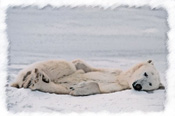Proactive disclosure
Print version   |  | 
Natural Resources Canada > Earth Sciences Sector > Priorities > Climate Change Impacts and Adaptation > Teacher's Guide
Climate Change in Canada Regional Aspects of Climate Change - Northwest Territories and Yukon Territory
Over the last 100 years, average annual air temperatures in the western Arctic have increased by about 1.5°C. General circulation models project that mean annual air temperatures for the Yukon Territory and the Northwest Territories will be 2°C to 5°C higher by 2050 than they were during the last 30 years of the twentieth century.
Permafrost, or permanently frozen ground, can be found in a significant portion of the Northwest Territories and the Yukon Territory and much of it is at temperatures within a few degrees of 0°C. If mean annual air temperatures increase by up to 5°C in the next 50 to 100 years, seasonal thaw will increase, and permafrost will become thinner or ultimately disappear. Thawing of ice-rich permafrost soils can results in settlement of the ground surface and this can cause foundations for buildings and other infrastructure to become unstable.
Potential regional impacts

- The body condition of caribou may decrease as they spend more energy digging for food beneath deeper snow packs. This makes it difficult for cows to acquire enough energy to give birth and raise their young. A reduction in the caribou population may result and this could have severe impacts on the communities that depend on them for food and maintenance of traditional lifestyles.
- The vegetation in northern Canada is well adapted to current climate. The Arctic Tundra zone will likely shrink in response to climate-warming and the treeline will shift northward.
- The species composition of forests will probably change as will the habitat for wildlife and this could lead to a change in the distribution of animal species. In addition, insects now found in southern Canada would move into northern Canada. Parasites and pests would also move northward and this could have adverse affects on plants and wildlife, as well as on the people living there.
- Under a warmer climate, there may be opportunities for agriculture in the central and upper Mackenzie valley region.
- The effects of climate warming on stream flow are not known with certainty. Increased precipitation could lead to an increase in stream flow, but this may be balanced by increased evaporation. Earlier and longer spring melt will result in changes in the timing and amount of spring runoff. A decrease in summer water levels could make navigation difficult.
- There may be a decrease in sea ice extent and an increase in the length of the melt season. Earlier breakup of ice may have adverse effects on seal and polar bear populations.
- Coastal erosion may increase as the frequency of damaging ice storms increases because of decreases in the amount of sea ice in the Beaufort coastal region in summer.
- Drier conditions and an increase in lightning storms are expected to result in an increase in forest fires in the Boreal Forest.
- Peat lands within the permafrost region provide important storage of carbon. Thawing or burning of permafrost-affected peat lands may result in an alteration of the carbon cycle and the concentration of atmospheric greenhouse gases.
Curriculum linkages
See Alberta curriculum linkages, as well as the Innuuqatigiit curriculum linkages in the following Nunavut section.
|


